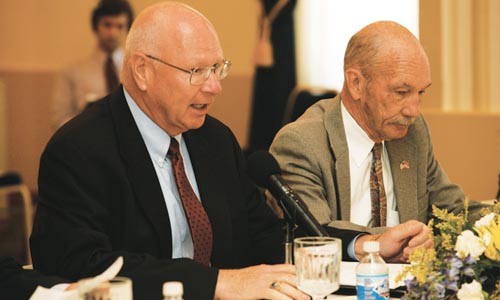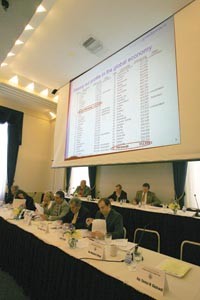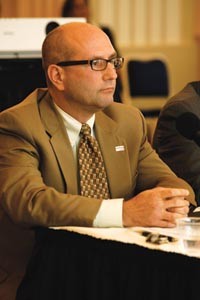Mayor Luke Ravenstahl left the ballroom and entered a crowd of cameras and reporters after testifying at a May 28 hearing convened by a panel of state representatives visiting from Harrisburg. Inside the hearing, seated next to county Chief Executive Dan Onorato, he had coolly presented his case for a massive overhaul of local government -- turning the 250-year-old city of Pittsburgh into an "urban services district" within a merged city/county government.
"One inevitable conclusion that we must reach together as a community is that we can no longer afford the status quo," Ravenstahl told the legislators. "We must change if we are to grow again."
The mayor is a relative latecomer to the consolidation party. As he acknowledged during his testimony, he was originally inclined to oppose it. But he's become a key ally for the pro-merger camp: a voice within the city -- some would say the voice of the city -- articulating the need for consolidation.
In the hallway outside the ballroom, however, he was making a different plea -- just trying to get people to take an interest. It wasn't coming easily, in part because reporters seemed far more interested in grilling him for taking a bodyguard to attend a Stanley Cup hockey game in Detroit.

After repeatedly urging them to refer such questions to public safety director Michael Huss, Ravenstahl gave his inquisitors a jab: "If you guys have any questions on important issues like merging the city and county, I'd be happy to answer them."
Eventually, they did get around to asking questions about the merger. But the dry granola of government consolidation couldn't compete with the red meat of a sports-related brouhaha. And no wonder: Advocates are balanced on a tightrope -- promising big changes, but pledging to protect the status quo at the same time. And for a merger to succeed politically, it can't even try to solve the most important problem in the region today.
Allegheny County faces some serious crises with no easy answers. Supporters of consolidation cite dispiriting Census bureau estimates suggesting that, since 2006, only New Orleans has experienced a greater population loss than the Pittsburgh metro area. Studies of job growth, meanwhile, show Pittsburgh lagging well behind similar cities across the country.
"Those statistics do not bode well for the future," says Brian Jensen, a senior vice president with the Allegheny Conference on Community Development, a consortium of business interests that has been one of the most consistent merger supporters. "So what do you do to change that? ... We are so behind the eight-ball here that we're going to have to do a lot of things." Consolidation won't solve all the area's problems, he says, but it's something "we're going to have to do."
Business leaders have long complained that political leadership in Allegheny County is badly fractured: The county has 130 municipalities, not to mention dozens of school districts, and any one of those borders could be a political fault line some day.
Jensen points to the collapse of the county's Skybus system -- a planned 60-mile transit system built on an elevated busway -- as an example of the pitfalls of fractured government. The system was never built, in large part because of disputes between the county, which supported the system, and the city, whose leaders opposed it and controlled land the project required.
"It was [Mayor] Pete Flaherty, and he, almost single-handedly, stopped the project," Jensen recalls. "He may have had good reasons for that, I'm not here to argue that, but the point is you have two different agendas.
"We've got too many examples over the years of the city and county going in their own separate directions, having their own agendas that don't coincide."
Ravenstahl and Onorato, both Democrats from the city's Brighton Heights neighborhood, have been an exception to that trend. In October 2006, they created a committee to find opportunities for making local government more efficient. Chaired by University of Pittsburgh Chancellor Mark Nordenberg, the committee released its report in support of a full-fledged merger in April 2008.
The report found that consolidated governments can provide "unity of leadership, increased planning and development capacity, simpler regulatory procedures for business, and reduced intergovernmental competition."
The Nordenberg report recommends a step-by-step approach for achieving those goals. The approach begins with intensified efforts to merge duplicate functions that both the city and county provide and ends with the voters being asked to decide if they want to merge the city and county completely.
It's unclear how the question will be presented to voters. Pennsylvania does have rules for merging municipalities that lie next door to each other, but the law that governs them does not apply to Pittsburgh -- the state's only city of the second class.
A merger like this one -- joining one municipality to the county, while leaving other municipalities in the county intact -- would create a fundamentally new unit of government in the commonwealth.
And how will the question reach the voters? As a single countywide ballot, or as a pair of referenda -- one for city voters, and the other for the county? If the latter approach, would city voters weigh in on both questions?
New rules will have to be drawn up from scratch, and Michael Gasbarre -- the executive director of the state legislature's bipartisan Local Government Commission -- says that the requirements for approval depend on "how [state legislators] craft the legislation" to enable a merger. Legal challenges are possible no matter what approach they come up with.
As they are being sold, consolidation plans would only affect the county's largest municipality. The city of Pittsburgh and Allegheny County would combine forces, but leave the county's 129 other communities with their governments intact. Consolidation wouldn't end backyard squabbles between those townships and boroughs, but supporters say that merging the two largest governments would help the region better chart its future. It could also save money.
"Here's the real reason you do the merger," Onorato says: "The city and the county both have a public works department, both have a parks and recreation department, both have a housing authority. We duplicate all these departments."
Technically, there's nothing preventing governments from sharing services now. The city and county share 911 call centers, for example, and Ravenstahl is offering city services to other municipalities, touting a successful garbage-collection deal with nearby Wilkinsburg as a sign that such deals can save money for both parties.
But Onorato says change must happen on a much more dramatic scale.
"Each one of those [consolidated departments] requires a separate negotiation, a separate agreement," he says. But "if you merge the two [governments completely], you sort of wrap these issues up into one and get it all done quickly."
Jensen says that consolidating city and county services could save as much as $38 million annually. "We think that's pretty conservative," he says of the estimate. "There may be some lowering of pressures on at least increases in taxes, if not an actual decrease in the tax rates."
But there are reasons to doubt Jensen's optimistic view. For all the talk of government inefficiency and redundancy, there's not as much overlap between city and county government as you might think.
"The bulk of the county's budget is human services and the court system. The city doesn't have either of those," says city Controller Michael Lamb (who formerly served as a county official, in charge of court records). "The bulk of the city's budget is police and fire. The county doesn't have a fire department and their police department is not a municipal police department."
Furthermore, some of the Nordenberg commission's own research raises questions about the benefits of a merger. A RAND Corporation study -- which was sponsored by the Nordenberg committee -- found evidence that suggests that "cost savings from consolidation are likely to be minimal or nonexistent." What's more, the study said, while consolidation "should help [regional] economic performance," there's no unequivocal evidence that it "does improve economic development."
Mostly that's because there isn't a wide pool of city-county mergers to base any conclusions on. And those that have taken place have varied widely in setting and structure, leading the Nordenberg report to conclude that "no past consolidations can easily be compared to the possible consolidation of Pittsburgh and Allegheny County."
But there's an even bigger reason to be wary of claims that consolidation can solve the region's problems. The biggest single problem facing a local government today -- Pittsburgh's whopping debt -- is the one issue the merger's supporters can't touch.
When it comes to debt, Onorato says, many of Pennsylvania's cities are struggling to stay afloat. But "Pittsburgh's the worst," he adds.
The city's debt derives from two sources: bonds issued in the past, and pension funds that are owed in the future. For years, Pittsburgh issued bonds to pay for improvements to infrastructure, while promising city employees retirement benefits that have become increasingly hard to pay for. Add in the debt issued by agencies like the Urban Redevelopment Authority -- which the city is ultimately responsible for -- and Lamb estimates the city has $2 billion in debt.
"I think it's safe to say that our debt load is pretty bad compared to most cities," says Chris Briem, a regional economist at the University of Pittsburgh. "Pittsburgh is really the center of this crisis for Pennsylvania" -- and as the city continues to lose population, the debt load will become more crushing.
The problem isn't new. In 2000, Lamb's predecessor, Tom Flaherty, released a report raising alarms about the city's debt. When compared to cities like Cincinnati and St. Louis "which all have similar population size as well as similar historical economic background," Flaherty's report found that "Pittsburgh is in the worst position."
The city has taken some steps to address the matter, though. Lamb says that tax revenues have been higher than expected, allowing the city to pay off some old debt while still paving roads and do other long-term projects. As a result, the bond debt has been wrestled down by roughly $100 million, from a high of $860 million.
"[T]he city is actually on a very good course right now with respect to its long-term debt," Lamb says. But it won't last. Costs will go on rising across the board, and sometime within the next few years, "We're going to get to that point where our expenditures are outpacing our revenues."
"[Pittsburgh is] flush with cash on a short-term basis, but the storm is coming for them," agrees Allegheny County Controller Mark Patrick Flaherty.
The county has problems of its own, of course. In fact, Flaherty says it's in just the opposite position of the city: While its long-term debt position is good, it isn't running short-term surpluses the way the city is, and thus it is plugging holes with one-time revenue fixes.
Not surprisingly, then, county residents don't want to be on the hook for the city's problems, too.
At the May 28 hearing on consolidation, M. Richard Dunlap, the executive director of the Allegheny League of Municipalities, testified about fears that suburbanites would be taxed "to pay off the city debts or subsidize the city to provide services to the core. The suburban communities would be opposed to any such indirect negative impact on their taxpayers."
In an interview, Dunlap says suburban residents just want to preserve the quality of life that attracted them in the first place. "The municipalities are given a bum rap of being obstructionists," he says. But "taxes are reasonable. Services are good. They're happy and they want to keep it that way."
Which gives rise to political truism about consolidation: "It is doomed to failure if it is in anyway seen as a bailout of the city's long-term debt," Lamb says. "It will not pass."
Suburbanites make up roughly three-quarters of the county's population, and as Flaherty puts it, "I don't think any voter would want to [take on] anybody else's debt."
Supporters of consolidation have sought to allay those fears. Onorato says municipal debt is bigger than this merger: "It's a crisis running across the state. There are so many cities that are having this problem that the state's going to have to ultimately intervene." In the meantime, he flatly pledged during his own May 28 testimony, "[S]uburban voters in no way will pick up the debt of the city or the unfunded pension of the city."
The Nordenberg report acknowledges that debt fears are among "the biggest hurdles that must be overcome." Its solution is to take the newly unified government and, well, divide it. The city would be dubbed as an "urban services district," while the rest of the county would be a "general services district," each with a distinct tax structure. Creating those districts can "ensur[e] that exiting city and county debt obligations remain segregated." While the report is hazy on details, it contends that the urban district "can 'hold' the existing debt and retire it over time by applying revenues ... through the differential tax structure."
At this point, city residents may be wondering: If the merger is going to do nothing about Pittsburgh's crushing debt, then why bother?
Even people who support the general idea of consolidation have fretted that it might amount to replacing the windows on a house that's collapsing.
The consolidation's hoped-for benefits "are terrific and I'd love to see them done," said state Rep. Dan Frankel (D-Allegheny) at the May 28 Urban Affairs Committee's subcommittee hearing. "But we are ignoring one of the core issues that confronts our city and our region, and that is how do we fix, in the long run, the city?"
In a five-year timeframe, he said, the city's finances are "not sustainable given the current structure, other than [by] cutting out services to the extent that is just unthinkable. ... These other issues that are latent -- the city's debt, the city's pension liabilities -- aren't part of the discussion."
Lamb suggests that the state might step in to relieve the city's debt in a larger way. Short of that, he says, there needs to be some motivation for city residents.
"Without that incentive, there's no real reason for people in the city to get excited about this proposal," he says. "There's got to be some benefit to them and it can't just be, 'Well, we're going to merge the city and the county and you're going to continue to get the services that you get.'"
Or as David Miller, associate dean of Pitt's Graduate School of Public and International Affairs, puts it, "It's going to be a real challenge to be able to articulate a city-county merger that has enough incentives to make it attractive to the voters of the city of Pittsburgh."
Indeed, "I don't call it so much a merger [as] eliminating the city of Pittsburgh and rolling it into the county," says City Council President Doug Shields. "I fail to see where the city would benefit from dissolving its own government," he says -- especially because the needs of city residents are often different. "If you look to our city code, the city code is a lot different than the county."
Pittsburgh offers numerous protections and rights that the county does not. For example, city workers are entitled to "domestic partner" benefits for same-sex and other unmarried but committed couples. The city also has a review board to look into police misconduct, and prohibits discrimination on the basis of sexual orientation. By contrast, GLBT people in the rest of county aren't even protected from housing discrimination.
"Certainly the GLBT community would not want to lose the gains they've made in the city of Pittsburgh," Shields says.
"The only way that I would support the merger is if the county or state had already put in the [legislation] necessary to protect sexual minorities," confirms Gary Van Horn, the president of the GLBT advocacy group the Delta Foundation. Van Horn, who says he met recently with Ravenstahl and Onorato to discuss a merger, adds that while "there's a lot of positives" to the proposal, "there could be a lot of negatives" as well.
The Nordenberg report does not address specifically what will happen to the city-specific services -- such as the police-review board or zoning codes. But in a one-page section titled "Meeting the Continuing Needs of the Urban Center," it suggests that the urban services district could be used to protect unique city laws even as it shields suburbanites from city debt.
Council members representing the district, the report suggests, could be provided special power -- through veto or other legislative rules -- over the budgeting and planning within the city's current boundaries. "The Urban Services District would assume that municipal function for what is now the City of Pittsburgh," the report states. Council members representing the area should be given "authority to ensure that the special needs of the urban core, which might extend beyond traditional services and also include protections for urban design and planning, are met."
In the meantime, members of the GLBT community aren't the only ones with reason for concern. Pittsburgh is only one-quarter of the county's population, so if you were a minority in the city before the merger, you'll really be one after it. According to the 2000 census, African Americans account for more than 26 percent of Pittsburgh's population -- but only 13 percent of the county. And their representation in government drops proportionally: Blacks hold two of the nine seats on Pittsburgh's city council, but just two of 15 seats on the county's part-time legislature.
The Nordenberg report suggests that there are ways to preserve minority representation, such as carefully drawing council districts or having at-large city council members (who are theoretically responsible to the entire city, and therefore must be mindful of minority voting blocs).
The report also cites testimony from Jensen that the "issue of minority representation has generally not been an overt problem in the various city/county consolidations" and "minority representation would not have to decline in consolidated City/County government" in Allegheny County.
Not everyone agrees. In merging a city like Pittsburgh, says Robert Morris University professor John McCarthy, "You're taking a weak political interest group and you're making it weaker."
McCarthy has made a study of consolidation efforts around the country. He says that in Indianapolis -- a city whose government reforms are widely touted -- consolidation has served to keep whites in power much longer than they would be otherwise. Since consolidating, he says, Indianapolis has had "a Republican mayor because they merged with the county." But "[t]hey'll never have a black mayor."
The same dynamic seems possible in a merged government here. Pittsburgh hasn't seen a Republican mayor since the 1930s, but Republican Jim Roddey did serve as the county's chief executive between 1999 and 2003.
Skeptics also worry that since the merger would leave most municipalities -- and all the school districts -- intact, it would do little to address broader social inequities. "A lot of minorities are not happy with a lot of the consolidation of things that have gone on in the southeastern part of the state, where I'm from," state Rep. Thomas Blackwell (D-Philadelphia), said at the May 28 hearing. "We should be consolidating where it can be [done], but to exclude one aspect that I think is very important, which is the school districts ... I don't want to see the same thing happen here that happened in the southeastern part of the state."
And that reveals the paradox: the merger can simultaneously be criticized for going too far -- by politically dissolving the city into the county -- and not far enough (standing clear of the city's gathering storm).
McCarthy says that governments frequently consolidate for one of two reasons. The first is what he calls "true reform" -- genuine equity in the funding of schools and other services. The second reason is for prestige: If nothing else, a city can claim a much larger population. A merged city/county would quadruple in size from roughly 300,000 people to more than 1.2 million -- all without adding a single resident.
"This is a shell game to hide population decline," McCarthy says. And it may also be a way for officials to make themselves "look like a reformer when they're not."
"It occurs to me that the whole thing is a put-up job to divert attention," says Jake Haulk, executive director of the Allegheny Institute, a conservative think-tank. Despite all the reforms promised by the bill, "None of that, from what we can see from their projections, is going to fix [the] problem. ... The city isn't growing."
And it's not just the city that needs an overhaul. The RAND report warns that the other 129 unmerged municipalities in the county will "remain drags on regional economic development" unless they, too, are merged.
But that gets back to the fact that "politically, that's never going to happen here," says Haulk. "So they're going for half a loaf, and it's not even half a loaf."
Indeed, if Pittsburgh government seems resistant to change, things aren't much better in many of the surrounding communities.
"We've been talking about trying to change the number [of municipalities] for a long time and haven't succeeded," says Susan Hockenberry, executive director of the Local Government Academy, a nonpartisan organization that provides training and education for good government. "If you make me queen tomorrow, I promise I'll change the number, but I'm not going to be made queen any day soon."
Even so, opportunities abound for intergovernmental cooperation -- without touching any municipal boundaries.
Some have been taken advantage of, such as the city's recent agreement to handle garbage collection for Wilkinsburg. The Local Government Academy maintains a Wiki page of intergovernmental success stories (igcsuccess.org).
The site lists the Northern Area Regional Police Department -- which was established in 1969 by three separate townships in Allegheny County -- as one triumph of intergovernmental work. It also includes the Butler County Sewage Association. Formed in 2000 by 12 municipalities, the Association now provides sewer services to 19 communities.
"Most often you see intergovernmental projects that meet a specific need for all the parties involved," Hockenberry says. "Not so much a discussion about, 'Well gee, there's a lot of governments in this area, we really ought to try to do things more together because that seems like the right thing to do,' which is how people who are observers of the system tend to look at it."
Onorato and Ravenstahl have pledged to keep working toward those types of functional consolidations even as they press the case for consolidation. Those deals may not be as ambitious as a sweeping reform like consolidation, but they offer tangible and immediate benefits -- something the merger's proponents have so far failed to do.
And they involve a much easeier sell. Skeptics continue to argue that there have to be stronger benefits for city residents if they're going to be asked to merge their government into the county's.
"I'm not against" a merger, McCarthy says. "I'm just against the way it's being handled. I've never heard anyone say this really would share these costs. If I did, I would have a different opinion of it."























